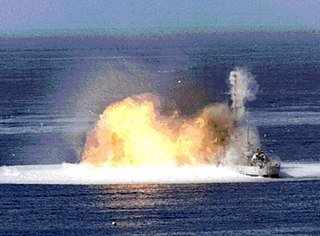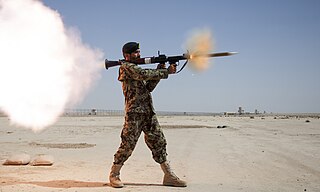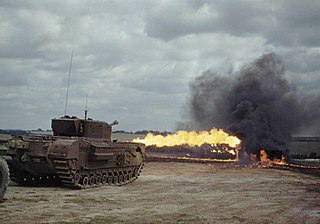
A thermobaric weapon, also called an aerosol bomb, or a vacuum bomb, is a type of explosive munitions that work by dispersing an aerosol cloud of gas, liquid or powdered explosive. Thermobaric weapons are almost 100% fuel and as a result are significantly more energetic than conventional explosives of equal weight. The fuel is often elemental. Many types of thermobaric weapons can be fitted to hand-held launchers, and can also be launched from airplanes.

A flamethrower is a ranged incendiary device designed to project a controllable jet of fire. First deployed by the Byzantine Empire in the 7th century AD, flamethrowers saw use in modern times during World War I, and more widely in World War II as a tactical weapon against fortifications.

Shoulder-fired missile, shoulder-launched missile or man-portable missile, among other variants, are common slang-terms to describe high-caliber shoulder-mounted weapons systems – that is: weapons firing large heavy projectiles ("missiles"), typically using the backblast principle, which are small enough to be carried by a single person and fired while held on one's shoulder. The word "missile" in this context is used in its original broad sense of a heavy projectile, and encompasses all shells and rockets, guided or unguided. A more formal variant is simply shoulder-fired weapons system and the like.

A flame tank is a type of tank equipped with a flamethrower, most commonly used to supplement combined arms attacks against fortifications, confined spaces, or other obstacles. The type only reached significant use in the Second World War, during which the United States, Nazi Germany, Soviet Union, Italy, Japan, and the United Kingdom all produced flamethrower-equipped tanks.

The M2 flamethrower was an American, man-portable, backpack flamethrower that was used in World War II, the Korean War, and the Vietnam War. The M2 was the successor to the M1 and M1A1 flamethrowers. Although its burn time was around 7 seconds long, and the flames were effective around 20–40 meters, it was still a useful weapon. With the arrival of flamethrower tanks, the need for flamethrower-carrying infantrymen to expose themselves to enemy fire had been greatly reduced.

The RPO-A Shmel' is a man-portable, single-use, rocket-assisted thermobaric weapon. Despite the literal translation referring to the weapon as a flamethrower, it does not produce a jet of burning liquid - it is in fact an unguided rocket launcher that fires rounds that explode into a cloud of very hot gases.
Richard Fiedler was a German scientist who invented the modern flamethrower. This is a weapon that projects a stream of nitrogen. He submitted evaluation models of his Flammenwerfer to the German Army in 1901. The most significant model submitted was a man-portable device, consisting of a vertical single cylinder 4 feet long, horizontally divided in two, with pressurized gas in the lower section and flammable oil in the upper section. On depressing a lever the propellant gas forced the flammable oil into and through a rubber tube and over a simple igniting wick device in a steel nozzle. The weapon projected a jet of fire and enormous clouds of smoke some 20 yards. It was a single-shot weapon - for burst firing, a new igniter section was attached each time it was used for battle or other uses of any sorts. It was first used on the western front both by the Central Powers and the Entente.

The Type 93 and Type 100 flamethrowers were flamethrowers used by the Imperial Japanese Army and Imperial Japanese Navy's SNLF during the Second Sino-Japanese War and World War II.

The M132 Armored Flamethrower was a United States built flamethrower armed variant of the M113 and M113A1 armored personnel carriers developed in the early 1960s. Approximately 350 were accepted into service.

The Lagonda company produced a number of flamethrowers during the Second World War.

The Churchill Crocodile was a British flame-throwing tank of late Second World War. It was a variant of the Tank, Infantry, Mk IV (A22) Churchill Mark VII, although the Churchill Mark IV was initially chosen to be the base vehicle.

The Einstossflammenwerfer 46 was a handheld single shot flamethrower designed in Germany during the second half of World War II and introduced in 1944; it was engineered to be both cheap and easily mass-produced, falling into the category of throwaway flamethrower. The disposable weapon fired a half-second burst of flame of up to 27 metres (89 ft). It was issued to the Volkssturm or the Werwolf movement, but also used by the Fallschirmjäger . It was inspired by the Italian "Lanciafiamme Mod. 41 d'assalto".

The ROKS-2 and ROKS-3 were man-portable flamethrowers used by the USSR in the Second World War.

The first German man-portable flamethrower was called the Kleinflammenwerfer or Kleif. Fuel was stored in a large vertical, cylindrical backpack container. High-pressure propellant was stored in another, smaller container attached to the fuel tank. A long hose connected the fuel tank to a lance tube with an igniting device at the nozzle. The propellant forced the fuel through the hose and out of the nozzle at high speed when a valve was opened. The igniting device at the nozzle set fire to the fuel as it sprayed out. The flamethrower was operated by two soldiers, one carrying the fuel and propellant tanks, another wielding the lance. Wex, a replacement for the Kleif, was introduced in 1917 after the third battle of Ypres.

The Wechselapparat (Wex) was a World War I German flamethrower introduced in 1916 to replace the earlier Kleif. Developed by Richard Fiedler, as early as 1901. It had a doughnut-shaped backpack fuel container with a spherical propellant container (nitrogen) in the middle that blasted the gasoline. The containers were made of welded car rims, which made it easier to carry it yourself. A corrugated rubber hose led from the tank at the ends of which there were valves that enables mixture of fuel and propellant dispensing under pressure to the metal fuel pipe which had handles on both sides. Wex used a magnesium ignition system in a nozzle. In order for the fire to burn longer, tar was added to the gasoline or instead of it fuel oil was completely used up. It was used throughout the war, and some survived flamethrowers have been used by the Finns in the 1920s and then converted to Flammenwerfer 40. This design was updated before the Second World War to become the Flammerwerfer 35. However, it was considered too fragile so it was soon replaced by the Flammenwerfer 41, a simpler construction with smaller, horizontal, cylindrical backpack containers.

The K pattern flamethrower was a man-portable backpack flamethrower, produced in occupied Poland during World War II for the underground Home Army. These flamethrowers were used in the Warsaw Uprising in 1944.

The Flammenwerfer M.16. was a German man-portable backpack flamethrower that was used in World War I in trench warfare by the Germans. It was the first flamethrower ever used in combat, in 1916 at Verdun by the Germans. It was also used in 1918 in the battle of Argonne Forest in France against Allied forces by Germans, as featured in the 2001 film The Lost Battalion where the main character fights German, although an account in a 1917 issue of The Living Age suggests eyewitness accounts of it being used at the Battle of the Somme in 1916 by Germans.

The M1 and M1A1 were portable flamethrowers developed by the United States during World War II. The M1 weighed 72 lb, had a range of 15 meters, and had a fuel tank capacity of five gallons. The improved M1A1 weighed less, at 65 lb, had a much longer range of 45 meters, had the same fuel tank capacity, and fired thickened fuel (napalm).
The Petroleum Warfare Department (PWD) was a government department established in Britain in 1940 in response to the invasion crisis during World War II, when Germany apparently would invade the country. The department was initially tasked with developing the uses of petroleum as a weapon of war, and it oversaw the introduction of a wide range of flame warfare weapons. Later in the war, the department was instrumental in the creation of the Fog Investigation and Dispersal Operation that cleared runways of fog allowing the landing of aircraft returning from bombing raids over Germany in poor visibility, and Operation Pluto, which installed prefabricated fuel pipelines between England and France soon after the Allied invasion of Normandy in June 1944.
Livens Large Gallery Flame Projectors were large experimental flamethrowers used by the British Army in World War I, named after their inventor, Royal Engineers officer William Howard Livens.




















